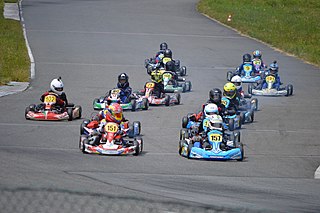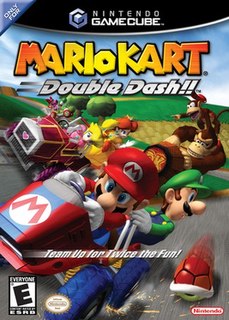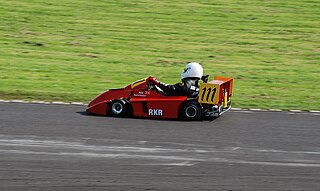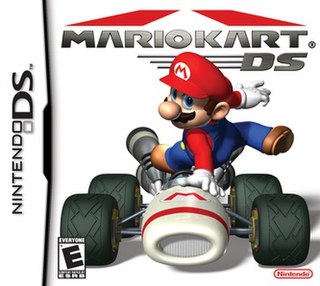Mario Kart is a series of racing games developed and published by Nintendo. Players compete in go-kart races while using various power-up items. It features characters and courses from the Mario series as well as other gaming franchises such as The Legend of Zelda, Animal Crossing, and Splatoon.

Super Mario Kart is a kart racing video game developed and published by Nintendo for the Super Nintendo Entertainment System. The first game of the Mario Kart series, it was released in Japan and North America in 1992, and in Europe the following year in 1993. Selling 8.76 million copies worldwide, the game went on to become the fourth best-selling SNES game of all time. Super Mario Kart was re-released on the Wii's Virtual Console in 2009, on the Wii U's Virtual Console in 2013, and on the New Nintendo 3DS's Virtual Console in 2016. Nintendo re-released Super Mario Kart in 2017 as part of the company's Super NES Classic Edition.

Mario Kart: Super Circuit is a kart racing video game developed by Intelligent Systems and published by Nintendo for the Game Boy Advance in 2001. The game is the third main entry in the Mario Kart series and the first for handhelds, following Super Mario Kart (1992) and Mario Kart 64 (1996). It was followed by the console game Mario Kart: Double Dash, which was released for the GameCube in 2003. The game retains traditional game elements of Mario Kart set by its predecessors, and received critical acclaim upon release.

Kart racing or karting is a road racing variant of motorsport with open-wheel, four-wheeled vehicles known as go-karts or shifter karts. They are usually raced on scaled-down circuits, although some professional kart races are also held on full-size motorsport circuits. Karting is commonly perceived as the stepping stone to the higher ranks of motorsports, with many former and current Formula One drivers such as Sebastian Vettel, Nico Rosberg, Ayrton Senna, Max Verstappen, Lewis Hamilton, Michael Schumacher, Kimi Räikkönen and Fernando Alonso, having begun their careers in karting.

Mario Kart 64 is a kart racing video game developed by Nintendo EAD and published by Nintendo for the Nintendo 64. The game is the second main entry in the Mario Kart series and is the successor to Super Mario Kart for the Super Nintendo Entertainment System. The game was first released in Japan on December 14, 1996, in North America on February 10, 1997 and in the United Kingdom on June 24, 1997. It was later released as a Virtual Console game for the Wii, Wii U, and on the Nintendo Switch Online + Expansion Pack service in 2007, 2016, and 2021, respectively.

Lytchett Minster is a village in Dorset, England. It lies around 4 miles (6.4 km) north-west of Poole town centre. The village forms part of the civil parish of Lytchett Minster and Upton, Upton now being a suburb of Poole.
Racing games are a video game genre in which the player participates in a racing competition. They may be based on anything from real-world racing leagues to fantastical settings. They are distributed along a spectrum between more realistic racing simulations and more fantastical arcade-style racing games. Kart racing games emerged in the 1990s as a popular sub-genre of the latter. Racing games may also fall under the category of sports video games.

Mario Kart: Double Dash is a 2003 kart racing video game developed by Nintendo Entertainment Analysis & Development and published by Nintendo for the GameCube. The game is the fourth main entry in the Mario Kart series and the third for home consoles after Mario Kart 64. It was preceded by Mario Kart: Super Circuit for the Game Boy Advance in 2001 and was followed by the handheld game Mario Kart DS, which was released for the Nintendo DS in 2005. It is the first game in the series to use 3D polygon graphics for the racers, as opposed to sprites.

Toranosuke "Tora" Takagi is a Japanese former racing driver.

Superkart is a form of motorsport road racing that uses karts on long circuits.

A go-kart, also written as go-cart, is a type of sports car, open-wheel car or quadracycle. Go-karts come in all shapes and forms, from non-motorised models to high-performance racing karts.

Mario Kart DS is a 2005 kart racing video game developed by Nintendo EAD Group No. 1 and published by Nintendo. It was released for the Nintendo DS handheld game console in November 2005 in North America, Europe, and Australia, and on December 8, 2005, in Japan. The game was re-released for the Wii U's Virtual Console in North America and PAL regions in April 2015 and in Japan in May 2016.
Mario Kart Arcade GP is an arcade sub-series of Nintendo's Mario Kart series, developed and published by Namco and later Bandai Namco Games under license from Nintendo. In all installments, for an additional fee, a player's data can be saved on a magnetic card which can be inserted into the machine again later to retain unlocked items and records. Nintendo had a limited role in development, mainly for quality control purposes. This game's arcade cabinet houses a camera that will take a photograph of the player's face. The photo can be customized and then will be displayed above the player's character during multiplayer races.

Crash Nitro Kart is a 2003 racing video game developed by Vicarious Visions and published by Universal Interactive for the PlayStation 2, Xbox, GameCube, and Game Boy Advance; versions for the N-Gage and mobile phones were released in 2004. It is the second racing game in the Crash Bandicoot series after Crash Team Racing and the first game in the series to feature full motion videos. The game's story centers on the abduction of Crash Bandicoot, along with other characters in the series, by the ruthless dictator Emperor Velo XXVII. Threatening to destroy the Earth if they refuse, he forces them to race in his gigantic coliseum for the entertainment of his subjects.

Mark Dismore is a former driver in the Indy Racing League and the 1990 Toyota Pacific champion as well as the winner of the 1993 24 Hours of Daytona with Dan Gurney's All American Racers in a Toyota GTP car with co-drivers Rocky Moran and P. J. Jones. He made 3 CART starts in 1991 but was badly injured in a practice crash for the Indianapolis 500, when his car veered sharply towards the entrance of pit road at the exit of Turn 4 and back-ended the fence, only to careen across the pit lane and smash virtually head on at sizeable speed against the edge of pit wall; this second impact tore off the front of the car leaving Mark's legs exposed. Amongst the injuries he suffered, the most severe was a broken neck. He was largely out of open wheel racing until the 1996 Indy 500 where he drove for Team Menard though he did try to qualify in the 1992 Indianapolis 500 for Concept Motorsports in an outdated Lola/Buick. In 1997 he drove a second car at the Indy 500 for Kelley Racing and would become a full-time fixture there until the 2001 season. He returned to Menard for a partial season in 2002. Dismore has a single IRL win coming in the fall 1999 Texas Motor Speedway race and also finished a career-best third in points that season. Among his 62 career IRL starts he won four poles. He also represented the IRL in the International Race of Champions in 2000 and 2001.

Speed Freaks is a racing video game developed by Funcom for the PlayStation for up to two players.

Mario Kart Wii is a kart racing game developed and published by Nintendo for the Wii. It is the sixth installment in the Mario Kart series, and was released in April 2008. Like its previous installments, Mario Kart Wii incorporates playable characters from the Mario series, who participate in races on over 30 different race tracks using specialized items to hinder opponents or gain advantages. The game features multiple single-player and multiplayer game modes including two to four person split screen. Online multiplayer was supported until the discontinuation of Nintendo Wi-Fi Connection in May 2014. Mario Kart Wii uses the Wii Remote's motion-controls to provide intuitive and conventional steering controls. Each copy of the game was bundled with the Wii Wheel accessory to augment this feature and mimic a steering wheel.

Mario Kart 7 is a kart racing video game developed by Nintendo EAD in cooperation with Retro Studios and published by Nintendo for the Nintendo 3DS in 2011.
An electric go-kart is a type of go-kart powered by electric motors and batteries, as opposed to traditional petrol engine. Electric go-karts are mostly intended for recreational usage, though high-performance models for a more serious kart racing are also offered.














